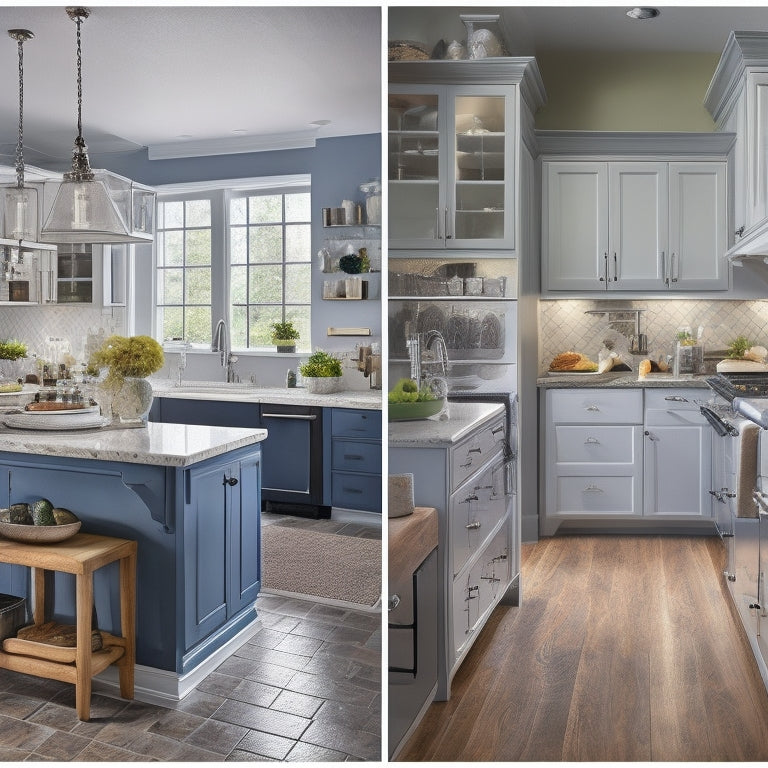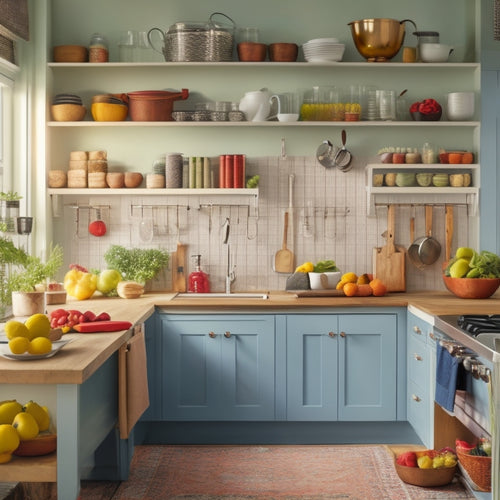
DIY or Pro? Choose Wisely for Kitchen Installation
Share
You're about to start a kitchen installation project, and the initial pivotal decision you'll make is whether to go DIY or hire a professional. This choice heavily influences the project's timeline, budget, and overall success. Weighing your expertise, time, and risks, DIY can be cost-effective upfront but may lead to future expenses. Hiring a pro saves time and headaches, but take into account your needs and budget. You'll need to decide between custom cabinets, requiring skill, and ready-to-install options, more suitable for DIY. As you progress, meticulous planning and preparation will be key to a successful installation, and it's crucial to contemplate the intricacies involved.
Key Takeaways
• Weigh the pros and cons of DIY and pro kitchen installation based on your expertise, time, and risk tolerance to make an informed decision.
• DIY installation can be budget-friendly upfront but may lead to potential future expenses, while hiring a pro saves time and headaches.
• Custom cabinets offer full design flexibility but require more skill and can be pricier, while ready-to-install cabinets are more DIY-friendly but have limited design choices.
• Accurate measuring and meticulous planning are crucial to avoid costly mistakes and ensure a smooth installation.
• Determine a realistic budget for kitchen installation, considering key factors like layout, finishes, and material quality, and prioritize your needs and wants.
Weighing DIY and Pro Options
When considering a kitchen installation, homeowners must carefully weigh the pros and cons of tackling the project themselves versus hiring a professional. The decision ultimately hinges on their level of expertise, available time, and willingness to take on the associated risks and responsibilities.
A cost comparison is an important aspect of this decision. DIY installation may be more budget-friendly upfront, but may lead to additional expenses down the line if mistakes are made. Hiring a professional will likely result in higher upfront costs, but can save you time and potential headaches in the long run.
Your time commitment is also a significant factor. DIY installation can be incredibly time-consuming, especially for those without experience. By carefully considering these factors, you can make an informed decision that suits your needs and budget.
Kitchen Installation Techniques Explained
Take a closer look at the two primary kitchen installation techniques: custom and ready-to-install cabinets, each requiring a different level of expertise and presenting unique benefits and challenges. As you explore your options, understanding the pros and cons of each approach is crucial.
| Custom Cabinets | Ready-to-Install Cabinets |
|---|---|
| Requires skill for intricate configurations | More suitable for DIY projects, easier to install |
| Provides full design flexibility | Limited design choices, standard sizes |
| Can be pricier | Generally more cost-effective |
When choosing between custom and ready-to-install cabinets, consider your design objectives, budget, and level of skill. Custom cabinets offer complete design flexibility but require more skill, while ready-to-install cabinets are more DIY-friendly but come with limited design options. By comprehending the distinctions between these two techniques, you can make an informed decision that aligns with your requirements and ensures a successful kitchen installation.
Preparing for a Smooth Installation
To guarantee a smooth kitchen installation, you must meticulously plan and prepare your space during the preparation stage, as it sets the tone for the entire project. This is where you'll select materials, verifying they're compatible and suitable for your design.
Measuring accurately is essential, as even the slightest miscalculation can lead to costly mistakes. Clear the kitchen space, removing old units and any obstacles or safety hazards. Gather necessary tools and equipment, and double-check your design plan to ensure a functional layout.
The Installation Process Uncovered
You'll begin the installation process by focusing on the base units, which serve as the foundation of your kitchen cabinetry, and require precise measurement and leveling to guarantee a sturdy and even installation.
From there, you'll move on to installing drawers, countertops, and upper cabinets, following detailed installation steps to assure a seamless fit.
However, be wary of common installation mistakes, such as miscalculating measurements or failing to secure cabinets properly, which can lead to costly reworks or even safety hazards.
Budgeting for a Dream Kitchen
When planning a kitchen installation, it's essential that you determine a realistic budget. Cabinets can greatly transform the kitchen's appearance, and key factors like layout, finishes, and material quality will impact costs beyond labor expenses.
To set a budget that works for you, consider budgeting tips such as setting aside 10-15% for contingencies and allocating funds for must-haves versus nice-to-haves.
Design considerations, like choosing custom or ready-to-install cabinets, will also influence your budget. Prioritize your needs and wants, and balance your financial means with your desired appearance and functionality.
Frequently Asked Questions
Can I Mix and Match DIY and Professional Installation Services?
You can mix and match DIY and professional installation services, but weigh cost comparison and time management carefully, as safety concerns and quality assurance may vary, impacting your kitchen's overall functionality and aesthetic appeal.
How Do I Handle Unexpected Electrical or Plumbing Issues During Diy?
"When unexpected electrical or plumbing issues arise, don't get electrocuted by uncertainty - instead, shock yourself into action by seeking emergency solutions from professional help, prioritizing safety measures to avoid sparking further problems."
What Are the Consequences of Not Leveling the Kitchen Floor Before Installation?
You risk costly flooring consequences and a significant budget impact if you don't level the kitchen floor before installation, leading to installation mistakes, safety hazards, and potential long-term damage to your kitchen.
Can I Reuse Old Kitchen Cabinet Hardware for My New Installation?
Before reusing old kitchen cabinet hardware, you investigate whether it's compatible with your new installation, considering factors like material, finish, and functionality, to guarantee a seamless integration, and weigh the cost benefits against purchasing new hardware.
Are There Any Specific Kitchen Layout Styles That Require Professional Installation?
When designing your kitchen, you'll find that modern designs with intricate layouts and rustic themes with custom elements often demand professional installation to guarantee precise execution and peak functionality, considering the complexity of these styles.
Related Posts
-

5 Best Kitchen Organization Templates With Shopping Lists
You're looking to transform your kitchen into a culinary haven with the help of organization templates and shopping l...
